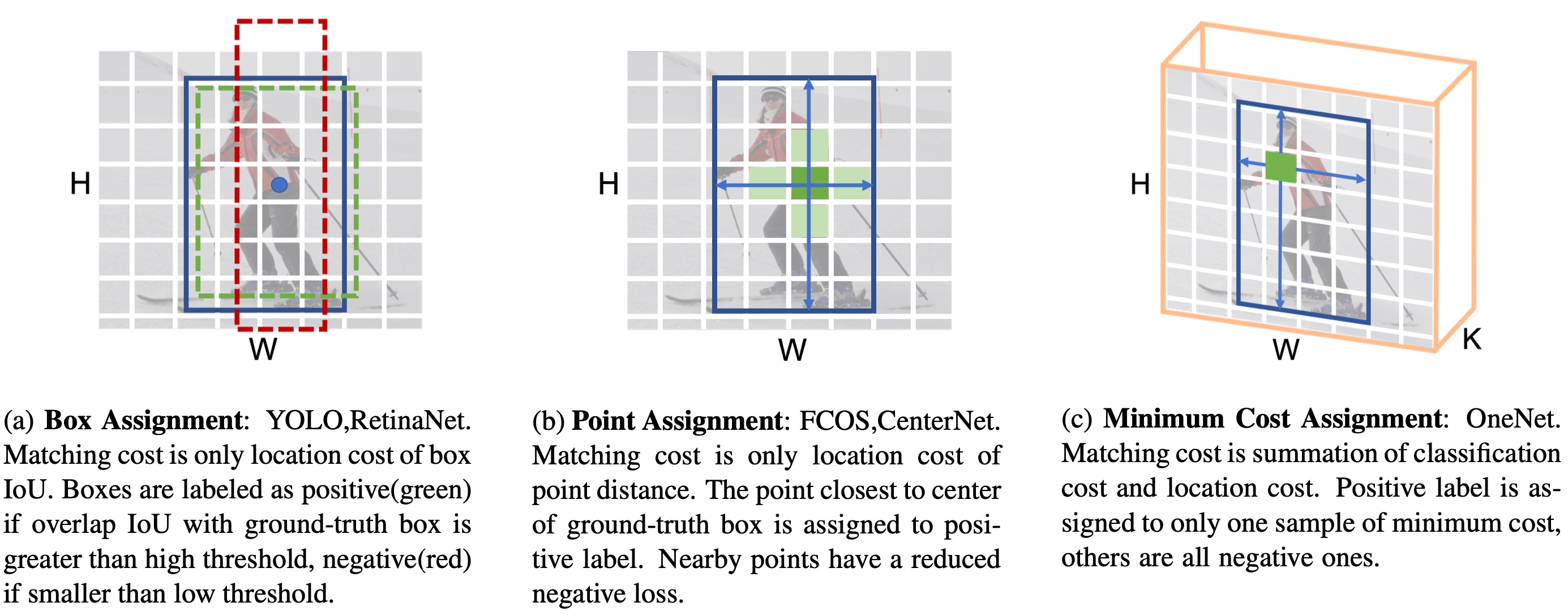Comparisons of different label assignment methods. H and W are height and width of feature map, respectively, K is number of object categories. Previous works on one-stage object detection assign labels by only position cost, such as (a) box IoU or (b) point distance between sample and ground-truth. In our method, however, (c) classification cost is additionally introduced. We discover that classification cost is the key to the success of end-to-end. Without classification cost, only location cost leads to redundant boxes of high confidence scores in inference, making NMS post-processing a necessary component.
arxiv: OneNet: Towards End-to-End One-Stage Object Detection
paper: What Makes for End-to-End Object Detection?
- (28/06/2021) OneNet.RetinaNet and OneNet.FCOS on CrowdHuman are available.
- (27/06/2021) OneNet.RetinaNet and OneNet.FCOS are available.
- (11/12/2020) Higher Performance for OneNet is reported by disable gradient clip.
- Provide models and logs
- Support to caffe, onnx, tensorRT
- Support to MobileNet
We provide two models
- dcn is for high accuracy
- nodcn is for easy deployment.
| Method | inf_time | train_time | box AP | download |
|---|---|---|---|---|
| R18_dcn | 109 FPS | 20h | 29.9 | model | log |
| R18_nodcn | 138 FPS | 13h | 27.7 | model | log |
| R50_dcn | 67 FPS | 36h | 35.7 | model | log |
| R50_nodcn | 73 FPS | 29h | 32.7 | model | log |
| R50_RetinaNet | 26 FPS | 31h | 37.5 | model | log |
| R50_FCOS | 27 FPS | 21h | 38.9 | model | log |
Models are available in Baidu Drive by code nhr8.
- We observe about 0.3 AP noise.
- The training time and inference time are on 8 NVIDIA V100 GPUs. We observe the same type of GPUs in different clusters may cost different time.
- We use the models pre-trained on imagenet using torchvision. And we provide torchvision's ResNet-18.pkl model. More details can be found in the conversion script.
| Method | inf_time | train_time | AP50 | mMR | recall | download |
|---|---|---|---|---|---|---|
| R50_RetinaNet | 26 FPS | 11.5h | 90.9 | 48.8 | 98.0 | model | log |
| R50_FCOS | 27 FPS | 4.5h | 90.6 | 48.6 | 97.7 | model | log |
Models are available in Baidu Drive by code nhr8.
- The evalution code is built on top of cvpods.
- The default evaluation code in training should be ignored, since it only considers at most 100 objects in one image, while crowdhuman image contains more than 100 objects.
- The training time and inference time are on 8 NVIDIA V100 GPUs. We observe the same type of GPUs in different clusters may cost different time.
- More training steps are in the crowdhumantools.
The codebases are built on top of Detectron2 and DETR.
- Linux or macOS with Python ≥ 3.6
- PyTorch ≥ 1.5 and torchvision that matches the PyTorch installation. You can install them together at pytorch.org to make sure of this
- OpenCV is optional and needed by demo and visualization
- Install and build libs
git clone https://github.com/PeizeSun/OneNet.git
cd OneNet
python setup.py build develop
- Link coco dataset path to OneNet/datasets/coco
mkdir -p datasets/coco
ln -s /path_to_coco_dataset/annotations datasets/coco/annotations
ln -s /path_to_coco_dataset/train2017 datasets/coco/train2017
ln -s /path_to_coco_dataset/val2017 datasets/coco/val2017
- Train OneNet
python projects/OneNet/train_net.py --num-gpus 8 \
--config-file projects/OneNet/configs/onenet.res50.dcn.yaml
- Evaluate OneNet
python projects/OneNet/train_net.py --num-gpus 8 \
--config-file projects/OneNet/configs/onenet.res50.dcn.yaml \
--eval-only MODEL.WEIGHTS path/to/model.pth
- Visualize OneNet
python demo/demo.py\
--config-file projects/OneNet/configs/onenet.res50.dcn.yaml \
--input path/to/images --output path/to/save_images --confidence-threshold 0.4 \
--opts MODEL.WEIGHTS path/to/model.pth
OneNet is released under MIT License.
If you use OneNet in your research or wish to refer to the baseline results published here, please use the following BibTeX entries:
@InProceedings{peize2020onenet,
title = {What Makes for End-to-End Object Detection?},
author = {Sun, Peize and Jiang, Yi and Xie, Enze and Shao, Wenqi and Yuan, Zehuan and Wang, Changhu and Luo, Ping},
booktitle = {Proceedings of the 38th International Conference on Machine Learning},
pages = {9934--9944},
year = {2021},
volume = {139},
series = {Proceedings of Machine Learning Research},
publisher = {PMLR},
}

